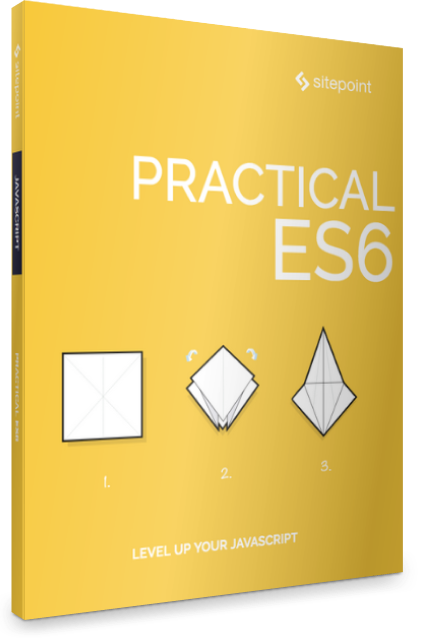About this book
There’s no doubt that the JavaScript ecosystem changes fast. Not only are new tools and frameworks introduced and developed at a rapid rate, the language itself has undergone big changes with the introduction of ES2015 (aka ES6). Understandably, many articles have been written complaining about how difficult it is to learn modern JavaScript development these days. We’re aiming to minimize that confusion with this set of books on modern JavaScript.
What you’ll learn
This book provides an introduction to many of the powerful new JavaScript language features that were introduced in ECMAScript 2015, as well as features introduced in ECMAScript 2016 and 2017. It also takes a look at the features planned for ECMAScript 2018 in this rapidly evolving language. It contains:
- New Keywords: let and const by Aurelio de Rosa
- Using Map, Set, WeakMap, WeakSet by Kyle Pennell
- New Array.* and Array.prototype.* Methods by Aurelio de Rosa
- New String Methods — String.prototype.* by Aurelio de Rosa
- New Number Methods by Aurelio de Rosa
- ES6 Arrow Functions: Fat and Concise Syntax in JavaScript
- Symbols and Their Uses by Nilson Jacques
- How to Use Proxies by Craig Buckler
- Destructuring Assignment by Craig Buckler
- ES6 Generators and Iterators: a Developer’s Guide by Byron Houwens
- Object-oriented JavaScript: A Deep Dive into ES6 Classes by Jeff Mott
- Understanding ES6 Modules by Craig Buckler
- An Overview of JavaScript Promises by Sandeep Panda
- JavaScript Decorators: What They Are and When to Use Them by Graham Cox
- Enhanced Object Literals by Craig Buckler
- Introduction to the Fetch API by Ludovico Fischer
- ES6 (ES2015) and Beyond: Understanding JavaScript Versioning by James Wright
- What’s New in ES2017: Async Functions, Improved Objects, and Moreby Craig Buckler
- What’s New in ES2018 by Craig Buckler
This book is for all front-end developers who wish to improve their JavaScript skills. You’ll need to be familiar with HTML and CSS and have a reasonable level of understanding of JavaScript in order to follow the discussion.
Where to buy
Get it as part of a monthly membership to SitePoint Premium – all our books and courses for only $9 a month!
Buy it now on Amazon or via Google Play or buy it as part of the Modern Javascript Collection
Frequently Asked Questions about Practical ES6
What is the significance of ES6 in JavaScript?
ES6, also known as ECMAScript 2015, is a significant update to JavaScript that introduced several new features and enhancements. It has made JavaScript more powerful and efficient, enabling developers to write cleaner, more readable, and maintainable code. ES6 introduced features like arrow functions, template literals, destructuring assignment, default parameters, and many more. These features have not only improved the coding style but also the performance of JavaScript.
How does ES6 differ from previous versions of ECMAScript?
ES6 brought about a major overhaul to JavaScript, introducing several new features and improvements that were not present in previous versions. Some of the key differences include the introduction of let and const for variable declarations, arrow functions for shorter function syntax, template literals for string concatenation, classes for defining objects, and promises for handling asynchronous operations. These features have made JavaScript more powerful and flexible, allowing developers to write more efficient and maintainable code.
How can I use ES6 features in my JavaScript code?
To use ES6 features in your JavaScript code, you need to ensure that your development environment supports ES6. Most modern browsers and JavaScript environments like Node.js support ES6. However, for older browsers that do not support ES6, you can use transpilers like Babel to convert your ES6 code into ES5 code that is compatible with older browsers. Once your environment is set up, you can start using ES6 features in your code.
What are arrow functions in ES6 and how do they work?
Arrow functions are a new type of function syntax introduced in ES6 that provide a shorter and more concise way to write functions in JavaScript. They are defined using the arrow (=>) notation. Arrow functions have two main benefits. First, they have a shorter syntax compared to traditional function expressions. Second, they do not have their own this value. Instead, they inherit the this value from the enclosing execution context.
What are promises in ES6 and how do they handle asynchronous operations?
Promises are a new feature introduced in ES6 for handling asynchronous operations in JavaScript. A Promise is an object that represents a value which may not be available yet, but will be resolved at some point in the future. It provides a way to handle the eventual result or error that results from an asynchronous operation. Promises have two main methods: then() for handling resolved values, and catch() for handling errors.
How does the let keyword in ES6 differ from the var keyword?
The let keyword is a new way to declare variables in ES6. Unlike var, which is function-scoped, let is block-scoped. This means that a variable declared with let is only accessible within the block it is declared in. This helps prevent issues related to variable hoisting and scope pollution, making your code more predictable and easier to debug.
What are template literals in ES6 and how do they improve string concatenation?
Template literals are a new feature in ES6 that provide a more powerful and flexible way to work with strings. They are enclosed by backticks ( ) and can contain placeholders for string interpolation. These placeholders are denoted by the dollar sign and curly braces (${expression}). Template literals make it easier to create multi-line strings and to embed expressions within strings, improving the readability and maintainability of your code.
How does ES6 improve object-oriented programming in JavaScript?
ES6 introduced classes, a new way to define objects in JavaScript. Classes provide a cleaner and more intuitive syntax for creating objects and dealing with inheritance. They make it easier to write object-oriented code in JavaScript, improving code readability and maintainability.
What are default parameters in ES6 and how do they work?
Default parameters are a new feature in ES6 that allow you to specify default values for function parameters. If a function is called without a value for a parameter that has a default value, the default value will be used instead. This makes your functions more flexible and easier to use.
How does ES6 handle modules and imports?
ES6 introduced a native module system for JavaScript. With this system, you can export functions, objects, or values from a module using the export keyword, and then import them in another module using the import keyword. This makes it easier to organize and manage your code, especially for large applications.


